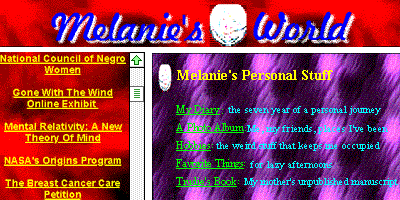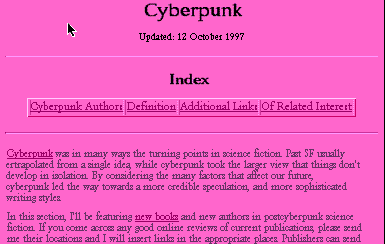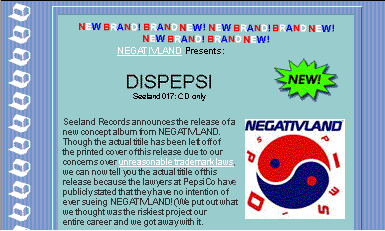The Answer
exploring here?
for Self
Expression,
with No
Specific
Audience
Example:

Sites
Discussion of Melanie's World: This site reflects Melanie's personality and interests. The items detailed will be of greatest interest to those who share these interests. Exploring the site actually reveals that Melanie also offers a product to consumers, but a focus on it has not taken over the site.
Example:

Sites
Discussion of the Cyberpunk page: This site is designed to provide information about Cyberpunk to anyone who searches on the word. It is aimed primarily at those with an interest in science fiction, and aims to show that cyberpunk represents an important contribution to this genre.
Example:

Sell a Product
or an Idea
Discussion of the "maps" page: This page was developed for a Freshman English class which meets in a computer class. The page was an easy way for class members to share each other's "mental maps" for discussion. The class had been studying mental as a way to think about how their ideas develop and change as they do research on their paper topics on unrelated topics. The mental maps are unlikely to be meaningful to those who have not done the class readings on mental mapping. They reflect various degrees of familiarity with the television shows which are their subject.
Example:

Discussion of the Dispepsi page: This page represents both a product and a political position. Negativland is a group that produces music, and Dispepsi is their latest CD. However, the CD is not widely available, and the site is designed to parody commercial themes and values.
Voyage!
If you aren't sure of how to find things on the World Wide Web, you might want to look at the Tips for Searching the Web available on this site.
If you already know how to search the Web, you can start right away to apply the skills covered in this tutorial, and to broaden them. There are plenty of other useful sites that can help you hone your critical thinking skills as you evaluate Web-based materials.
Happy surfing!
Sections
![[Identify the Source]](ID_on.gif)
![[Identify the Source]](EV_on.gif)
![[Find the Audience]](FI_off.gif)
